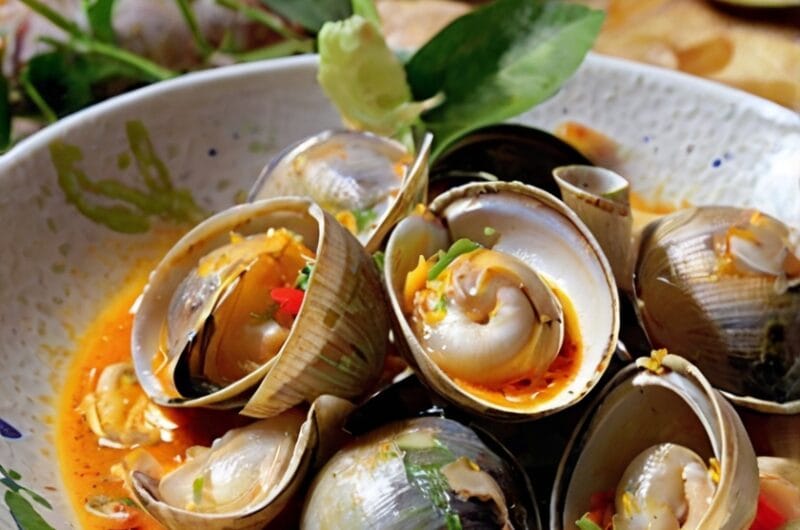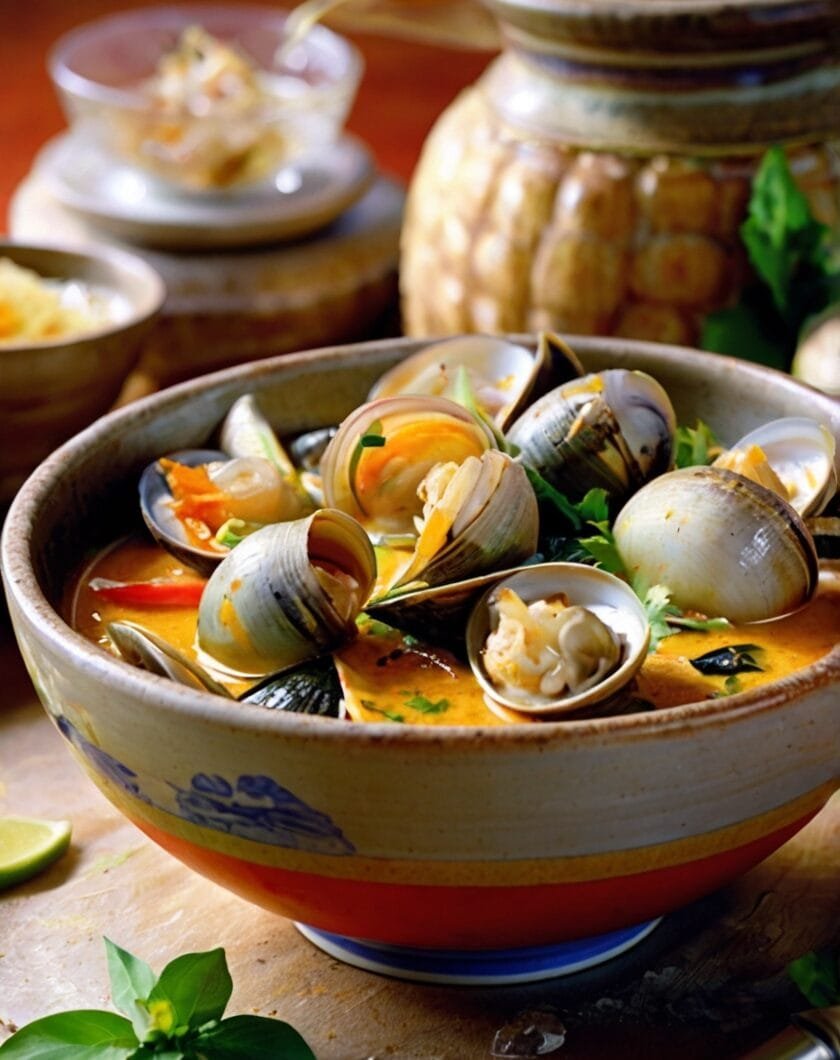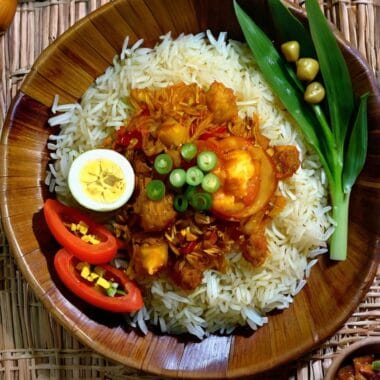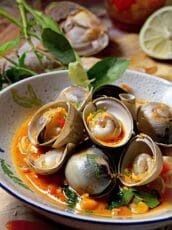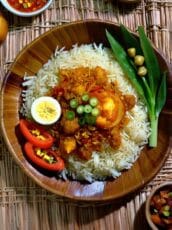If you’re looking for a dish that’s both healthy and packed with bold, unforgettable flavor, this is it. Thai Red Curry Coconut Clams are a flavor explosion in the best way—sweet and creamy coconut broth, a hint of spiciness from Thai red curry paste, and all those fragrant Thai aromatics that make your kitchen smell like magic. It’s cozy, exotic, and surprisingly easy to pull together.
Introduction to Thai Red Curry Coconut Clams
Thai cuisine is renowned for its harmonious balance of flavors, combining the spicy, sweet, sour, and salty elements to create a unique culinary experience. One dish that exemplifies this balance is the Thai Red Curry Coconut Clams. Originating from coastal regions of Thailand, this dish reflects the country’s rich seafood culture, where fresh clams are abundant and commonly utilized in various recipes. In this dish, clams are paired with a vibrant red curry sauce, bringing together the essence of Thai flavors.
The foundation of Thai Red Curry Coconut Clams lies in the creamy, aromatic sauce created from a mixture of red curry paste, coconut milk, and a medley of spices and herbs. The red curry paste, made from ingredients such as red chilies, garlic, ginger, and lemongrass, offers a robust spiciness that is balanced beautifully by the richness of the coconut milk. This fusion results in a luxurious sauce that envelops the clams, enhancing their natural briny flavor while adding an exciting kick.
When prepared correctly, this dish offers an exhilarating taste experience. Each bite showcases tender, juicy clams complemented by the smooth and fragrant curry sauce. The harmony of flavors truly transports one to the tropical shores of Thailand, highlighting the country’s dedication to fresh ingredients and culinary artistry. As the vibrant colors and aromatic scents fill the air, preparing Thai Red Curry Coconut Clams becomes not just a cooking task, but a delightful exploration of textures and tastes. The dish serves not only as a testimony to Thai culinary traditions but also as an invitation for adventurous food enthusiasts to embark on a tropical culinary journey.
Ingredients You Will Need
To prepare a delightful Thai Red Curry Coconut Clams dish, it is essential to gather the right ingredients that enhance both flavor and authenticity. First and foremost, you’ll need fresh clams. Varieties such as Manila clams or littleneck clams are preferable due to their sweet and tender meat, which complements the spicy and aromatic red curry. Ensure that the clams are alive prior to cooking; discard any that remain open and do not close when tapped.
The star of this recipe is the red curry paste. It’s advisable to use a high-quality brand or homemade red curry paste to ensure that the depth of flavor is achieved. This paste is typically made from a blend of red chilies, garlic, lemongrass, kaffir lime leaves, and spices, and provides the distinctive heat characteristic of Thai cuisine. Adjust the quantity according to your desired spice level, with about three tablespoons being a good starting point.
Next, coconut milk is vital for this recipe. Full-fat coconut milk offers a rich and creamy texture that beautifully balances the heat from the curry. Additionally, you will need garlic and shallots, which will create a flavor base that marries well with the clams and coconut milk. Fresh lime juice adds a touch of acidity to brighten the dish, while fish sauce enhances the overall umami profile.
For garnish and added texture, consider cilantro and sliced red chilies. These not only elevate the presentation but also provide fresh, herbal notes that complement the dish. Lastly, serve the clams with jasmine rice or crusty bread to soak up the sumptuous sauce, providing a complete dining experience that reflects the essence of Thai culinary traditions.
Preparation Steps
Before diving into the culinary adventure of preparing the Red Curry Coconut Clams, it is essential to meticulously execute the initial preparation steps. This phase lays the foundation for not only a smooth cooking process but also a flavorful outcome.
The first critical step is to clean the clams thoroughly. Rinse them under cold running water to remove any sand or debris. It is advisable to let them soak in a bowl of fresh water for about 20 minutes, allowing them to expel any remaining grit. After soaking, give the clams another rinse to ensure they are clean and ready for cooking. Proper cleaning of the clams is vital for both hygiene and the overall flavor of the dish.
Simultaneously, gather and chop the necessary vegetables, which will complement the dish beautifully. Common choices include bell peppers, onions, and cilantro. Aim for uniform sizes to ensure even cooking. The vibrant colors and fresh scents will enhance the dish’s visual appeal and flavor profile. Additionally, prepare the garlic and ginger by mincing them finely; these ingredients are aromatic and integral to the curry’s base.
Next, it is essential to assemble the necessary kitchen tools. A large skillet or wok is ideal for cooking the clams and the sauce together. Furthermore, have a chopping board, knife, measuring spoons, and a spatula ready at hand. Having these tools conveniently accessible will streamline the cooking process, allowing you to focus on bringing the dish together without any interruptions.
Finally, gather all ingredients in one area to ensure you have everything needed at your fingertips, including red curry paste, coconut milk, and your cleaned clams. Proper preparation not only provides efficiency but also contributes significantly to a delightful culinary experience.
Cooking the Dish
To prepare a delicious red curry coconut clams dish, start by gathering all the necessary ingredients: fresh clams, red curry paste, coconut milk, bell peppers, garlic, and shallots. Begin by cleaning the clams thoroughly under cold running water to remove any sand or grit. This step is vital for ensuring a clean, flavorful final dish.
Next, heat a tablespoon of vegetable oil in a large skillet or wok over medium heat. Once the oil is hot, add finely chopped shallots and garlic, sautéing them until they become translucent and fragrant. This technique not only builds a flavorful base but also enhances the overall aroma of the dish. After a few minutes, add diced bell peppers, stirring them into the mixture. Continue to sauté until the peppers soften slightly, which typically takes about three to five minutes.
Once the vegetables are adequately softened, incorporate two to three tablespoons of red curry paste into the skillet. Stir the paste into the vegetables, allowing it to infuse with the sautéed ingredients for an additional minute. This step is crucial as it releases the complex flavors of the curry paste, setting the stage for a rich, aromatic dish. Slowly pour in the coconut milk, mixing it well with the ingredients to create a creamy sauce. Bring the mixture to a gentle simmer, allowing the flavors to meld together beautifully for approximately five minutes.
Finally, add the cleaned clams to the simmering sauce, ensuring they are well coated. Cover the skillet with a lid to help the clams cook evenly. Within roughly five to seven minutes, the clams will open, signaling they are properly cooked. Discard any clams that remain closed, as they may not be safe to consume. Serve the red curry coconut clams hot over steamed jasmine rice for a complete and satisfying meal.
Tips for Perfect Clams
Cooking clams to perfection requires attention to timing and technique to ensure a delicious result. One of the essential tips for achieving perfectly cooked clams is to start with fresh seafood. Look for clams that are tightly closed or close when tapped, which indicates they are alive and fresh. Avoid any clams with cracked shells or those that remain open, as they are likely dead and should not be consumed.
When preparing to cook clams, soak them in saltwater for about 20 minutes prior to rinsing. This process helps expel sand and impurities, ensuring a cleaner taste. Timing plays a crucial role once they are in the pot. Generally, clams should be steamed for approximately 5 to 10 minutes. They are done when the shells have fully opened. It is important to monitor them closely because overcooking can result in rubbery textures, diminishing the overall quality of the dish.
In terms of doneness, you should be aware that some clams may take longer than others to open fully. If you find that certain clams remain closed after cooking, it is advisable to discard them, as this is a sign that they may be spoiled. Furthermore, it is recommended to avoid prying them open, as this can compromise the dish’s integrity. To further prevent overcooking, consider removing the clams from heat as soon as they open, then allowing them to sit in the residual heat of the pot. This method ensures they remain tender and succulent while minimizing the risk of becoming tough.
Implementing these tips will enhance your cooking experience and result in perfectly cooked clams that contribute to your Thai red curry coconut clams recipe. Enjoy the process and savor the flavors that perfectly steamed clams can bring to this vibrant dish.
Serving Suggestions
When it comes to presenting your Red Curry Coconut Clams, the aesthetics of the dish can greatly enhance the dining experience. To start, consider using a wide, shallow bowl for serving, which not only showcases the vibrant colors of the curry but also allows for easy access to the delectable clams. A simple white porcelain bowl or a rustic earthenware dish can provide a striking contrast against the bold hues of the red curry, enticing your guests even before the first bite.
Garnishing plays a pivotal role in elevating your dish. Fresh herbs such as cilantro or Thai basil work exceptionally well to provide a burst of color and flavor. Sprinkling a handful of finely chopped herbs atop the clams just before serving introduces an aromatic freshness, enhancing both visual appeal and taste. A few lime wedges arranged around the bowl can also add a zesty touch, inviting diners to squeeze extra citrus over their servings for additional brightness.
Pairings further complement the richness of the curry, offering a delightful balance to the dish. Jasmine rice is a classic choice, providing a fragrant and fluffy base that absorbs the creamy sauce beautifully. Alternatively, serving with crusty bread allows guests to scoop up the luscious curry and savor all the flavors in each bite. For a complete Thai experience, consider serving a side of pickled vegetables or a light cucumber salad, which can add a refreshing crunch to your meal.
Ultimately, the presentation and garnishing of your Red Curry Coconut Clams can transform a simple dish into a vibrant centerpiece, making it a feast for both the eyes and the palate. Adopting these serving suggestions will not only enhance the overall dining experience but also invite conversation and appreciation among your guests.
Flavor Pairings
When enjoying red curry coconut clams, it is essential to consider complementary flavors that can enhance the overall dining experience. The richness of the coconut milk and the spiciness of the red curry create a delightful balance that can be mirrored in beverage selections and side dishes.
For beverages, one of the most traditional Thai drinks, Thai iced tea, proves to be an excellent pairing with red curry coconut clams. This sweet, creamy beverage provides a refreshing contrast to the heat of the curry, while its subtle tea flavor harmonizes with the spices. Alternatively, a light-bodied white wine, such as Sauvignon Blanc or Riesling, can also complement the dish nicely. These wines possess a crisp acidity that cuts through the richness of the coconut milk, enhancing the overall taste without overshadowing the flavors of the clams.
In terms of side dishes, consider serving jasmine rice, which is a staple in Thai cuisine. The fragrant rice serves as a neutral base that absorbs the flavorful curry sauce, making every bite more enjoyable. Additionally, a fresh green papaya salad (som tam) adds a crunchy, tangy element to the meal, balancing the creamy texture of the clams and providing a refreshing counterpoint to the heat. Another great accompaniment could be a simple stir-fried vegetable medley, incorporating ingredients such as bok choy, bell peppers, and snow peas. This not only introduces more vibrant colors to the plate but also offers a variety of textures that enhance the experience.
Incorporating these beverage options and side dishes alongside red curry coconut clams can create a harmonious meal, showcasing the rich flavors of Thai cuisine and delivering a memorable dining experience.
Health Benefits of Clams and Coconut Milk
Clams are a highly nutritious seafood option, boasting an impressive nutritional profile that can enhance overall health. They are particularly rich in protein, offering approximately 20 grams of protein per 100 grams serving, making them an excellent choice for those looking to increase their protein intake. This high protein content is essential for muscle growth, tissue repair, and supporting overall bodily functions. Furthermore, clams are low in calories and fat, which makes them a suitable component in weight management diets.
In addition to their protein content, clams are an excellent source of vital nutrients including vitamins B12 and C, iron, and selenium. Vitamin B12 plays a critical role in nerve function and the production of DNA and red blood cells, while iron is necessary for the transport of oxygen in the blood. The presence of selenium, a powerful antioxidant, helps to protect the body from oxidative stress and supports thyroid function. Incorporating clams into your diet not only provides essential nutrients but also contributes to a balanced and healthy eating regime.
On the other hand, coconut milk, derived from the meat of mature coconuts, is rich in healthy fats, particularly medium-chain triglycerides (MCTs). MCTs have been associated with various health benefits, including enhanced energy expenditure, improved cognitive function, and promoting heart health. Additionally, coconut milk contains lauric acid, which has antimicrobial properties that can help in strengthening the immune system. Combining clams with coconut milk not only enhances flavor but also boosts the nutritional value of any dish, making it a delicious and healthful choice.
Ultimately, the inclusion of clams and coconut milk in recipes such as the red curry coconut clams not only elevates the flavor but also serves to provide a range of health benefits suited for an nourishing meal. Their unique nutrient profiles create a balanced dish that supports overall health while satisfying the palate.
Frequently Asked Questions
Cooking can often raise questions, especially when trying new recipes like the Red Curry Coconut Clams. Below are some common inquiries that might arise while preparing this delightful dish.
Can I substitute the clams for another type of seafood?
Yes, while clams are integral to this Thai dish, you can substitute them with other seafood options such as mussels, shrimp, or scallops. These alternatives will maintain the essence of the recipe and still provide a delicious flavor profile.
What if I cannot find red curry paste?
If red curry paste is not available, you can create a makeshift version using individual spices. Combine cayenne pepper, paprika, garlic powder, and a bit of ginger to mimic the taste. Alternatively, consider using yellow curry paste; while it offers a distinct flavor, it can still yield an enjoyable dish with a slightly different profile.
Is there a non-dairy alternative I can use instead of coconut milk?
For those who are lactose intolerant or prefer non-dairy options, almond milk or any plant-based milk can serve as a substitute. However, note that the richness and creaminess of coconut milk may not be fully replicated, so you might want to enhance the flavor with some additional spices or a dash of vegetable broth.
How can I enhance the dish’s flavor?
To deepen the flavor of the Red Curry Coconut Clams, consider adding fresh herbs such as cilantro or basil towards the end of cooking. A sprinkle of lime juice can also brighten the dish, balancing the richness of the coconut milk. Additionally, incorporating vegetables like bell peppers, zucchini, or bok choy can add extra texture and nutrition, making the dish even more appealing.
